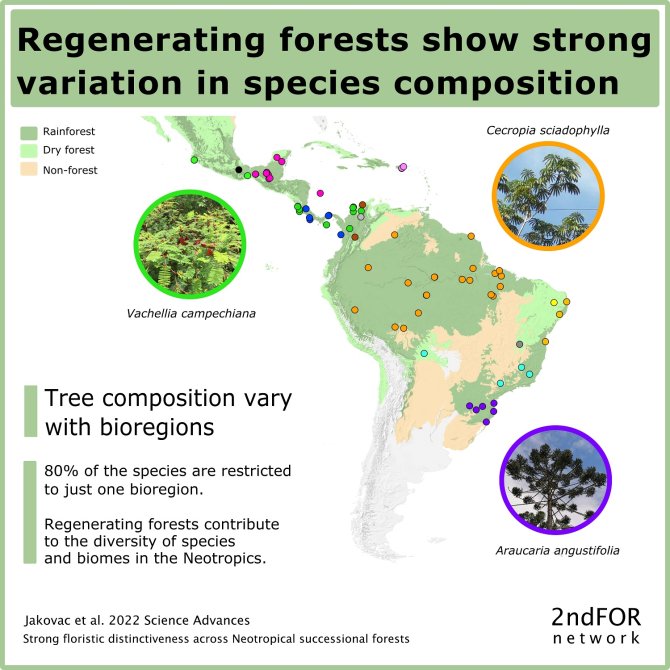
News
Regenerating forests contribute to maintaining the diversity of tropical species and biomes in the Americas
A study published today in Science Advances shows that tropical forests that regrow naturally on abandoned agricultural lands are not all the same and thus can help to restore and conserve the distinct ecological regions (biomes) across the Americas. The team of ecologists established 1,215 plots in young regenerating forests from western Mexico to southern Brazil. These forests hold a large floristic diversity, which is the combined result of evolutionary history and current environmental conditions.
Surprising outcome: 14 floristic regions
The study from the international 2ndFor Network found that the species composition of young regenerating forests (less than 20 years old) is highly variable across the continent, forming 14 distinct floristic regions (Figure).

This finding is surprising, as it was thought that these young forests
would be dominated by the same small set of widespread pioneer species. Lead author Prof. Catarina Jakovac from the Federal University of Santa Catarina in Brazil explains that “Pioneer species typical of young forests are usually abundant and dispersed by generalist animals, so we thought that most of them would be able to reach faraway sites like the widespread Trema micrantha and Guazuma ulmifolia.”
However, the study showed that being widespread is not the rule in these young forests and that 80% of the 2,164 species analysed were present in only one floristic region. Different groups of species thrive in each region, and therefore regenerating forests can help conserve the diversity of biomes across the continents.
Variation by biogeographic history and recent environmental conditions
Why is there so much variation in species across these regenerating forests? The study showed that the species composition we see today is the combined result of old biogeographic history and recent environmental conditions. Co-author Prof. Marielos Peña-Claros (Wageningen University & Research), explains that “Over evolutionary history, some regions experienced an intense exchange of species with different biogeographic origins but other regions were kept apart by geographical and ecological barriers.”
For example, some 3 million years ago the land connection between North and South America led to an important exchange of species between Middle America and the Amazon. By contrast, the Southeast and Southern Atlantic forest regions have a very distinct composition of species from the Amazon. This is likely because they were separated by a dry region, which is nowadays the Cerrado biome, for around 33 millions of years.
““Global changes may induce shifts in species composition”
On top of evolutionary history, variations in current environmental conditions lead to variations in species composition. Different floristic regions vary in soil pH, temperature seasonality, and water availability. Some early-successional species, despite their ability to disperse across long distances, can only thrive under specific environmental conditions. But if these environmental conditions change, the composition of species can change along, blurring the distinction between biomes. Land use modifies soil pH and climate change leads to an increase in temperature and stronger seasonality in water availability.
Shifts in species composition lead to a homogenization of forests and reducing continental-scale distinctiveness.
Prof. Lourens Poorter, the senior author of the study and based at Wageningen University concludes that “Global changes may induce, therefore, shifts in species composition, potentially leading to a homogenization of these forests and reducing continental-scale distinctiveness.”
Priority to local species
To avoid and mitigate such consequences, forest restoration initiatives should pay a lot of attention to species selection and should prioritize local species in their restoration efforts. Jakovac emphasises that “This will help restore both local forests and large-scale diversity while also conserve the distinct biomes acrossthe continent.”